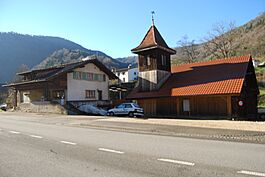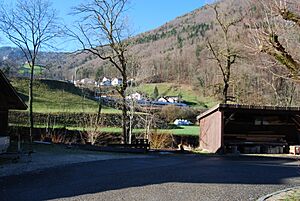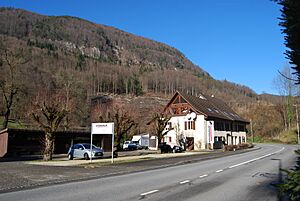Roches, Switzerland facts for kids
Quick facts for kids
Roches
|
||
|---|---|---|

Roches village
|
||
|
||
| Country | Switzerland | |
| Canton | Bern | |
| District | Jura bernois | |
| Area | ||
| • Total | 9.06 km2 (3.50 sq mi) | |
| Elevation | 491 m (1,611 ft) | |
| Population
(Dec 2020 )
|
||
| • Total | 190 | |
| • Density | 21.0/km2 (54.3/sq mi) | |
| Postal code |
2762
|
|
| Surrounded by | Moutier, Belprahon, Grandval, Rebeuvelier (JU), Courrendlin (JU), Vellerat (JU), Châtillon (JU) | |
Roches (say "rosh") is a small town, also called a municipality, in Switzerland. It is located in the Jura bernois administrative district in the canton of Bern. This area is known as the French-speaking Bernese Jura.
History
Roches was first written about in the year 1308. Back then, it was called Roschers.
For a long time, the village was owned by the leader of the Moutier-Grandval monastery. This was under the rule of the Prince-Bishop of Basel. A Prince-Bishop was a bishop who also ruled a territory like a prince.
In 1798, France invaded Switzerland. Roches then became part of a French area called Mont-Terrible. A few years later, in 1800, it moved to another French area called Haut-Rhin. After Napoleon was defeated, and a big meeting called the Congress of Vienna happened, Roches became part of the Canton of Bern in 1815.
In 1791, a glass factory opened in Roches. Célestin Châtelain bought the factory in 1817 and ran it until 1840. Two years later, he opened a new glass factory in nearby Moutier. This factory grew to be very important for making window glass in Switzerland.
Even with the glass factory, Roches was mostly a farming village. In 1876, a railroad opened a station in Roches. This made the village a small industrial center for a while. However, this growth did not last long. Today, only small businesses operate in Roches.
Geography
Roches covers an area of about 8.97 square kilometers. A large part of this land, about 71.4%, is covered by forests. About 23.4% of the land is used for farming.
A smaller part, about 3.9%, has buildings or roads. A tiny bit, 0.9%, is rivers or lakes. The rest, 0.3%, is land that cannot be used for anything.
Most of the forested land is thick forest. Some parts have orchards or small groups of trees. For farming, some land is used for pastures where animals graze.
The town is located along the Birs river. This river flows through a narrow valley called the Moutier Canyon.
In 2010, Roches joined a new administrative area called Arrondissement administratif Jura bernois. Before that, it was part of a different district.
Coat of Arms
The official symbol of Roches, its coat of arms, shows a special picture. It is split down the middle. One side is red, and the other is silver. In the middle, there is a picture of a monastery. The colors of the monastery are opposite to the background colors.
Population
Roches has a population of about 212 people (as of December 2011). A small part of the people living here, about 6.9%, are from other countries.
Most people in Roches speak French. About 81.8% of the population speaks French as their main language. The second most common language is German, spoken by about 15.1% of the people. A small number, 1.3%, speak Italian.
In 2008, about half the people were male (49.8%) and half were female (50.2%). Many people living in Roches were also born there. About 34.7% of the people in 2000 were born in Roches.
Children and teenagers (up to 19 years old) make up about 15.6% of the population. Adults (20 to 64 years old) are the largest group, at 65.1%. Older people (over 64 years old) make up 19.3%.
Most homes in Roches are lived in all the time. In 2011, almost half of the homes (47.5%) were single-family houses.
Here is a chart showing how the population of Roches has changed over time:

Economy
In 2011, the unemployment rate in Roches was very low, at 1.29%. This means almost everyone who wanted a job had one.
In 2008, 45 people worked in Roches. These jobs were in different areas:
- Primary sector: 20 people worked in farming or forestry. There were 8 businesses in this area.
- Secondary sector: 14 people worked in manufacturing (making things) or construction. There were 4 businesses here.
- Tertiary sector: 11 people worked in services, like shops or restaurants. There were 4 businesses in this area.
Many people who live in Roches travel to other towns for work. In 2000, 86 workers left Roches to work elsewhere, while 39 came into Roches for work. About half of the workers in Roches also lived there.
Most people (69.7%) used a private car to get to work. A smaller number (8.2%) used public transportation like buses or trains.
Religion
Based on a survey in 2000, people in Roches belonged to different religious groups:
- About 42.2% were part of the Swiss Reformed Church.
- About 31.6% were Roman Catholic.
- Some people belonged to other Christian churches (about 10.22%).
- About 5.33% did not belong to any church or were agnostic (meaning they don't know if God exists) or atheist (meaning they don't believe in God).
- About 10.22% did not answer the question about their religion.
Education
In Roches, about 39.2% of adults have finished high school (called "upper secondary education"). About 13.6% have gone on to higher education, like a university.
The school system in the Canton of Bern works like this:
- One year of optional Kindergarten (for young children).
- Six years of Primary school, which everyone must attend.
- Three years of lower Secondary school, which is also required. Students are grouped by their abilities.
- After secondary school, students can choose to continue their studies or start an apprenticeship (learning a job while working).
During the 2011-2012 school year, 11 students attended primary school in Roches. There were no kindergarten classes in the town.
In 2000, 16 students lived and went to school in Roches. However, 25 students from Roches went to schools in other towns.
See also
 In Spanish: Roches (Berna) para niños
In Spanish: Roches (Berna) para niños






